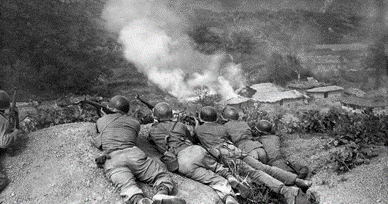1/ People tend to believe past success and a bias towards the status quo alone predicts the future. If victors don't continuously develop, train, and improve then their next battle might be a humiliating failure like Task Force Smith at the Battle of Osan. 

2/ In June of 1950 the United States was caught with its pants around its ankles in the Far East for the second time in less than a decade as a heavily armed and trained North Korean (DPRK) Army steamrolled across the 38th Parallel and invaded US ally South Korea (ROK). 

3/ Despite the newly created CIA having seen the North Korean Army moving towards the border, the CIA assusred everyone the move was "strictly defensive in nature". The invasion and the speed at which the Communists rolled over their southern cousins surprised everyone. 

4/ Especially stunned was General William Roberts (the man responsible for training South Korea’s Army) who had claimed that any invasion from the north would be “target practice” for the ROK army, Neither the ROK Army nor their US allies were in a position to defend South Korea. 

5/ While the Soviet Union had provided the North with hundreds of modern T-34-85 tanks, the US had provided South Korea with precisely 0 tanks or anti-tank weapons.
As the unarmed and untrained ROK Army fled before the onslaught, the United States decided to intervene.
As the unarmed and untrained ROK Army fled before the onslaught, the United States decided to intervene.

6/ The state of the new ROK Army could be excused, but the state of the United States military, who less than five years before had won the Second World War could not. The peacetime Army was a disaster. Convinced future war was nuclear, they had cannibalized conventional forces. 

7/ The National Security Act of 1947 had created the Air Force, the NSC and the CIA, but had relegated Army ground combat units to second priority in acquisitions and funding. Nearly every division hovered around 60% strength, with most of the enlisted men being raw recruits. 

8/ Equipment was often obsolete WW2 vintage, and most of the leaders were connected officers who had been spared the rigors of prolonged combat assignments in WW2 and were now being given box check time in Command. 

9/ Commander of the Far East Theatre Douglas MacArthur demanded an “arrogant display of strength” and selected the “most ready” unit in the Far East: 1st Battalion, 21st Infantry Regiment. Except they were in fact, not ready. They had lied on their readiness reports.
10/ Their commander, LTC Charles Smith, a West Pointer who hadn’t seen combat since Guadalcanal in 1942 knew his battalion was in trouble. They cannibalized one infantry company to add bodies to the remaining two, and shanghaied officers from other regiments to fill their ranks.
11/ Armed with little more than small arms and bazookas that had proven useless against tanks in WW2, Task Force Smith grabbed two days of food, a handful of hope, big giant brass balls, and flew into Korea to slow the communist tide. 

12/ Luckily, TF Smith was joined by Battery A, 52nd Field Artillery and their six 105mm howitzers. Going into battle against a modern armored formation, the artillerymen knew they needed anti-tank rounds if they were to have any hope at all. 

13/ Sadly the US Military, logistical masters of the world, had only 18 anti-tank artillery rounds in the entire Far East Theatre. TF Smith was given six. The US Army went into battle with a wheel gun’s worth of rounds. 

14/ TF Smith took their positions alongside a road outside of Osan on July 4, 1950 in a beautiful defensive position, with two hills overlooking a flat road and miles of open wet ground that could funnel the communist tanks into a narrow kill box where the column could be… 

15/ …stopped and then massacred. Except the Americans had no anti-armor mines to stop anything, and only 6 rounds to stop scores of enemy tanks. But try the young Americans did. Flinging their rounds at the Communist tanks, they managed to knock one out, and disable another. 

16/ Great news, except the remaining Soviet built tanks rolled through the rest of the American line like it wasn’t even there. Young Lieutenant Ollie Connor personally grabbed a bazooka, and at a range of 15 yards tried to fire into the weak rear armor of the T-34-85. 

17/ The young officer fired 22 times, with absolutely no effect. As the hopelessness of the endeavor sunk in, the discipline of the untrained Americans started to buckle. Artillerymen fled their guns, but were shamed into returning when their officers and NCOs took their place. 

18/ But the battle was lost. Following the tanks came and entire division of North Korean infantry. At first the 500 Americans held against the 5,000 men of the 4th North Korean Infantry Division. 

19/ But as the 120 rifle rounds per man the Americans left Japan with began to dwindle, the need to retreat became apparent. LTC Smith ordered the line to pull back by section, trying to replicate young Lt Godfrey’s fighting retreat at the Little Bighorn.
https://twitter.com/6Voodoo/status/1638898625160916993?s=20
20/ But Task Force Smith had never trained as a unit and despite being “ready” on paper, they were a fucking clown show. Platoons were forgotten, wounded men and equipment left behind to the North Koreans, and the retreat quickly became a shameful rout.
21/ As the wounded Americans who could not walk were tied up and executed by the North Koreans, everyone on that battlefield knew the Army of the United States of America was no longer a serious fighting force. 

22/ While propagandists might call it a heroic delaying action against superior numbers it was an embarrassing disaster. The US Army’s TF Smith hadn’t even lasted half a day against a North Korean Army that hadn’t even existed five years prior.
23/ In the span of 5 years the US Army had allowed themselves to degenerate from the masters of the known world, to an abomination that couldn’t even equip a handful of men in the field properly. The following weeks saw the North Korean Army smash more American units. 

24/ The North Koreans captured a General and beclowned the US Army again and again all the way to Pusan. It was the Army’s most humiliating hour since the fall of the Philippines at the beginning of WW2. (the Japanese had captured 18 generals and 100,000 men in the Philippines) 

25/ They hadn’t planned, they hadn’t thought, they hadn't rehearsed, and they hadn’t prepared, and for a few months in 1950, less than five years after their greatest triumph, the role of the United States as a super-power looked like it hung in the balance.
26/ And this ladies and gentlemen, is why you don't wait until Thanksgiving morning to turn on your WiFi grill like @HardPass4 . You do rehearsals, you plan and prepare, and you do better. 

• • •
Missing some Tweet in this thread? You can try to
force a refresh













